How to Use Keyword Tiering to Triple Your Paid Search Profit
by Jacob Baadsgaard • April 11, 2017
Ever wonder why it’s so hard to run a paid search campaign that meets your business needs?
To be honest, paid search is something of a balancing act.
You want more clicks, but you can’t afford to pay for the wrong clicks. You need more leads, but low-quality leads are a waste of time and money. You have to have sales, but those sales also have to be profitable for your business.
Between all of these competing priorities, it can be hard to call any paid search campaign a runaway success. In fact, it may be tempting at times to throw your hands up in the air and give up.
But what if I told you that there was a way to balance all of these conflicting priorities? A way to juggle traffic, conversions, sales and profitability without dropping the ball?

As it turns out, there is a way to have your cake and eat it too. All you have to do is learn how to effectively prioritize your paid search ad spend using a technique I like to call “keyword tiering.”
The Problem With Keywords
If there’s one thing we’ve learned after auditing well over 2,500 AdWords accounts, it’s that not all keywords are created equal.
[Tweet “Not all keywords are created equal.”]
The problem is, while some keywords are a huge waste of money and need to be eliminated, you can’t just bid on your branded terms because they are your top performers. You need traffic and conversion volume, too, which means you sometimes have to bid on sub-optimal keywords.
But, the more sub-optimal keywords you bid on, the less profitable your account is…
In most cases, a good AdWords account manager will try to find some sort of compromise between volume and profitability. Sure, not every keyword will be super-profitable, but you get decent conversion volume at a decent price.
That’s all you can really ask for, right?
Well, before we jump to conclusions, there’s one more factor to consider that we haven’t discussed yet: bandwidth. In any given month, week, day or even hour, your business needs change.
Sales people go on vacation. Inventory gets overstocked. Businesses set aggressive growth goals. Marketing budgets get cut. For any number of reasons, the number of conversions and sales your business can handle may change.
This creates a very interesting opportunity.
If half of your sales team is on vacation, does it make sense to pay for a bunch of decent-quality leads that no one is around to close? Not really.
Sure, you could cut your ad spend back, but what if—instead of cutting spend on all your keywords—you simply stopped spending money on your less-profitable keywords?
If your goal is to sell hundreds of extra units this month, does it make sense to limit sales by only bidding on your most profitable keywords? Again, not really.
But what if—instead of overbidding on your top keywords—you started bidding on keywords that drove a lot more sales? (even if they weren’t as profitable).
This is where keyword tiering comes into play.
In a nutshell, keyword tiering is all about assigning your keywords to “tiers” that you can turn on or off as your business needs change. So, if the CEO want to double sales, you turn on an extra tier or two. If 2 hours later you learn that a freak fire destroyed half of your warehouse, you shut some tiers off.
Either way, your ad spend delivers what your business needs right now at the best possible price.
How to Set Up Keyword Tiering
Fortunately, setting up keyword tiering is actually quite easy. Here’s how:
Step 1. Check Your Tracking
Before we dive too deep into keyword tiering, let me emphasize that you must have high-quality conversion tracking in place for keyword tiering to work.
Keyword tiering is only as effective as the data you use to create your tiers, so if you don’t have several months-worth of high quality conversion tracking data, you’ll need to get that set up before you can get started.
It’s fairly easy to track form completions in AdWords, but for keyword tiering to work, you have to track every conversion action that matters to your business. Here is a list of potential conversion actions you may need to be tracking (click the links to read an article on how to set up conversion tracking for that action):
Only about 29% of AdWords advertisers have high-quality conversion tracking in place, so if your account falls into the 71% of AdWords accounts with inadequate tracking, fixing that problem needs to be your top priority.
In addition, if the goal of your AdWords campaigns is to generate leads, you need to know which keywords produce which sales. Remember, the whole point of keyword tiering is to identify your most profitable keywords, so if you don’t know how profitable your keywords are, you won’t be able to create very effective tiers.
Step 2. Categorize Your Keywords
Once you have at least 1-2 sales cycles-worth of solid conversion and sales tracking data, you can use that data to set up your keyword tiers.
The “right” keyword tier strategy will vary from business-to-business and can even evolve over time. However, I generally recommend starting with around 4 tiers.
Here’s a sample set of tiers we’ve used for lead gen clients:
Tier 1. Proven sales and profitability
These keywords are the cream of the crop. They consistently produce profitable sales and usually drive the majority of your revenue.
Unless you really need to cut back on leads (ie, your sales team is swamped), Tier 1 keywords should always be left running. After all, if you turn these keywords off, you are missing out on profitable new business.
Along the same lines, these keywords should never miss out on potential impressions due to budget limitations.
Yes, if a keyword isn’t profitable above a certain average position, it’s okay to miss out on some impression share due to ad rank. But, these keywords are your money makers, so if you are going to pay for impressions, pay for impressions on these keywords first.
Tier 2. Producing sales
Tier 2 keywords are usually a reliable source of marketing-qualified leads and sales, but for some reason those sales are not always as profitable as you would like.
Your cost-per-click may be on the higher side. Your conversion rate may be low. Your price point may be too high for these leads or the lifetime value of these clients may be low. Whatever the reason, Tier 2 leads are a far less reliable source of profitable revenue for your business than Tier 1 leads.
In many cases, a little optimization can actually turn a Tier 2 keyword into a Tier 1 keyword. If that happens, promote the keyword from Tier 2 to Tier 1 and give yourself a pat on the back. But, until then, leave that keyword in Tier 2.
If you’re trying to bulk up lead volume and you’ve maxed out impression share on your Tier 1 keywords, Tier 2 keywords are the obvious next step. Your account won’t be quite as profitable, but you’ll usually get solid leads and sales at a reasonable price.
Tier 3. No sales…yet
Tier 3 keywords show some promise, but they haven’t really delivered yet. These keywords may drive a lot of promising leads, but you can’t really predict when or if those leads will actually turn into paying business.
If you have a hungry sales team and you’re already maximizing impression share on your Tier 1 and 2 keywords, turn on Tier 3! A hungry sales person can often turn an unproven lead source into a reliable winner.
Tier 4. Producing leads…and that’s about it
Tier 4 is something of a crapshoot. These keywords produce leads, but they are often a poor match for your business, unresponsive or trying to sell you something.
But, every so often, there’s a nugget in there that makes it all worth it.
In general, I prefer to leave Tier 4 keywords off until the sales team is really complaining about lead volume. Most of the time, Tier 4 keywords end up being expensive busywork for the sales team, but if it’s between the sales team getting frustrated and losing momentum and risking money on lower-quality leads, it’s often better to run your Tier 4 keywords until the sales team gets busy with Tier 1-3 leads again.
Tiering Tips
The actual number of tiers that you use (along with what sorts of keywords you include in each tier) will depend on your business. For example, if you are running an eCommerce business, you might only bid on keywords that you know are profitable.
In this scenario, you might sort your keywords by their return-on-ad-spend (ROAS) as follows:
- 10x or better ROAS
- 7-9x ROAS
- 4-6x ROAS
- 2-3x ROAS
In general, if a keyword hasn’t produced any conversions in the last 3+ months, it’s a dud keyword and shouldn’t be included in any of your tiers. That being said, you should have a testing budget you can use to try out new keywords, but those keywords also shouldn’t fall under any of your tiers.
Ultimately, though, there is no right or wrong way to use keyword tiering. You just need to make sure that your tiers allow you to focus your ad spend on the keywords that produce the right value at the right time. That way, your low-quality keywords never steal budget away from your top tier keywords and you keep everyone from sales-to-CEO happy.
Step 3. Label Your Tiers
Once you’ve categorized your keywords, you need a way to sort your keywords by tier in AdWords. The easiest way to do this is using labels.
If you’ve never created labels in your AdWords account before, simply open up your account and click the “Keywords” tab. Add the labels column to your report by clicking “Columns”, hitting the double arrow next to “Labels” and clicking “Apply.”
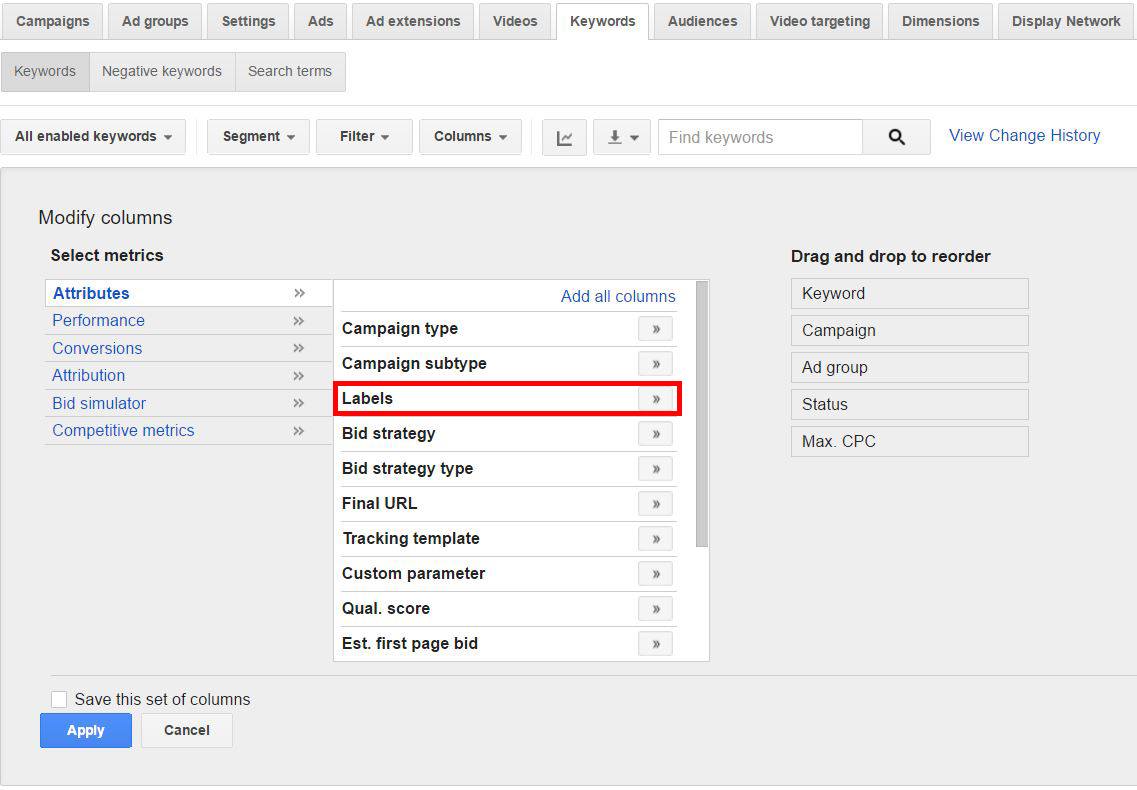
Next, check the boxes by all of your Tier 1 keywords.
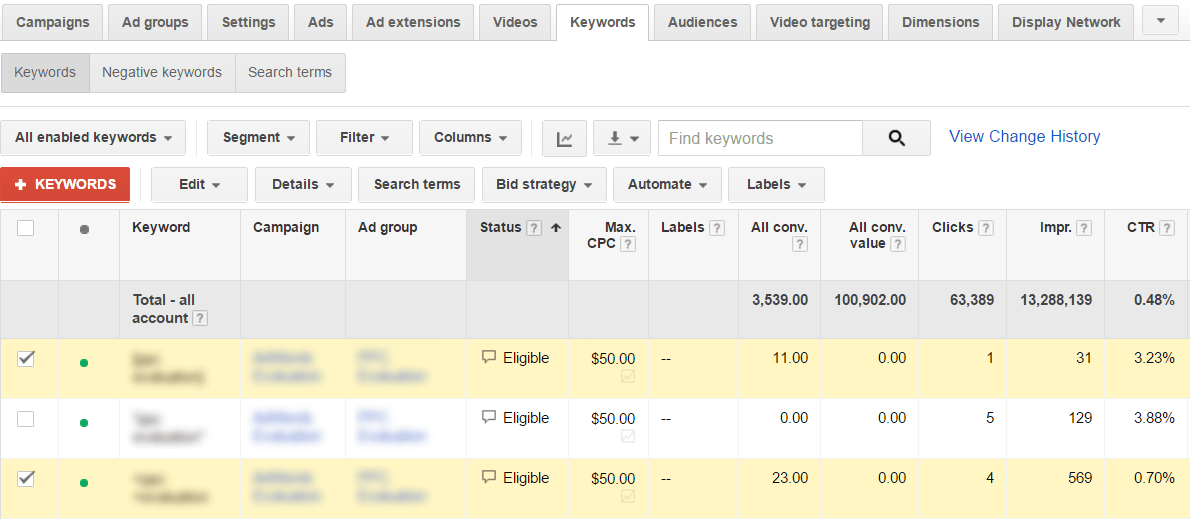
And click the Labels dropdown menu.
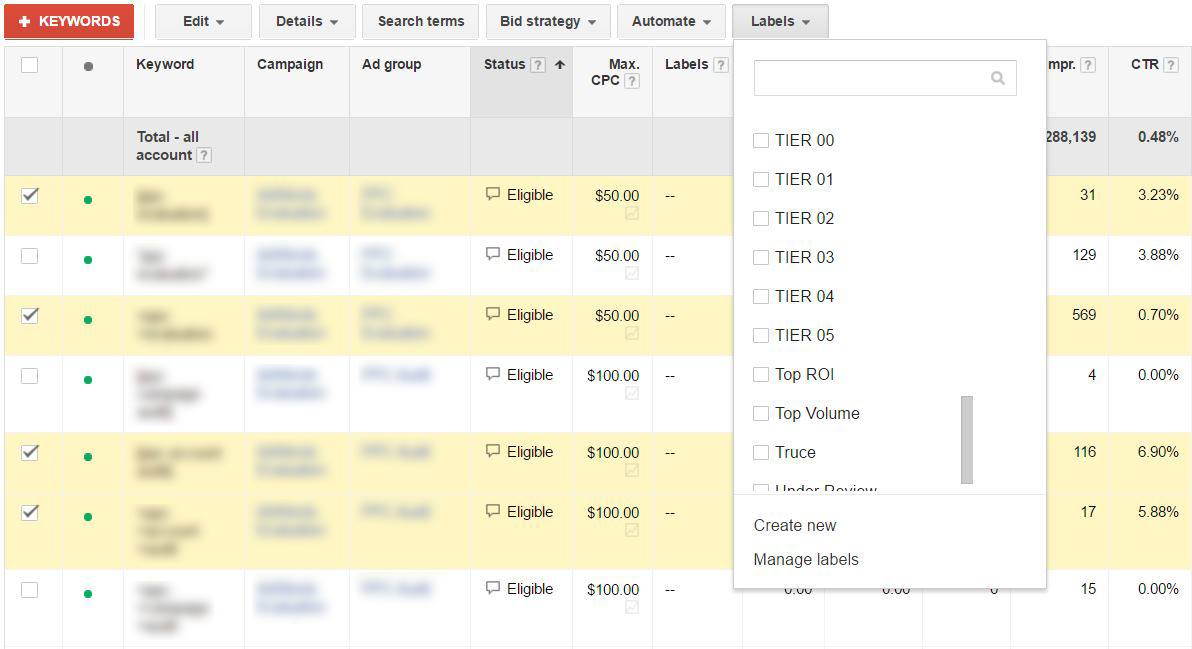
If you’ve already created your labels, all you have to do is check the box next to the tier you want your keyword(s) to be in. Otherwise, you’ll have to click “Create new” and create some new labels.
Once you’ve labeled all of your Tier 1 keywords, use the same process to label the keywords in all of your other tiers. Note, you can also do this in AdWords editor, which will speed things up considerably for accounts with a lot of keywords.
Step 4. Maximize Profitability
Once you have your keyword tiers set up, it’s time to start using them! First, you’ll want to create some custom filters for each tier that you can use to quickly pull up a list of keywords in that tier.
From the Keywords tab, all you have to do is click the Filter drop down menu and then click “Create filter”.
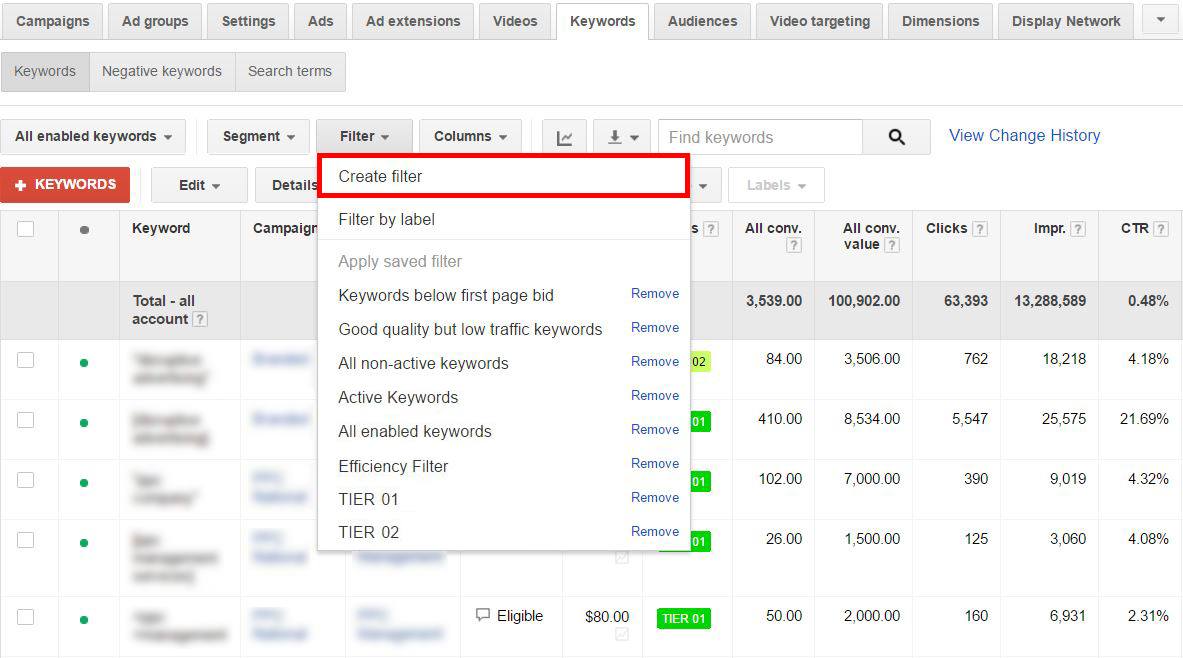
Set your filter to filter for “Labels contains any” and check the box for your chosen tier.
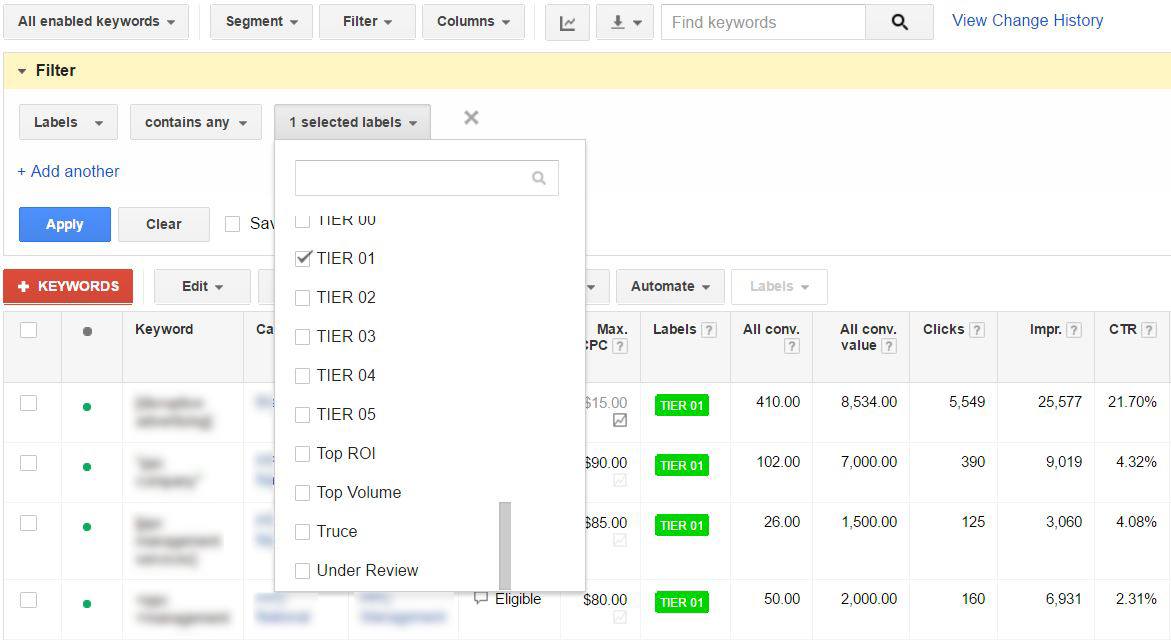
Name your filter, check the box next to “Save filter” and hit Apply.

Voila! Now you can pull up all of the keywords in that tier with a couple of clicks. You can repeat this process for all of your other tiers, or even combinations of your tiers that you frequently need to access.
So, if your sales team reports that they are swamped with leads, you can just pull up your Tier 2, 3 and 4 filters, check the select all box and click Edit > Pause.
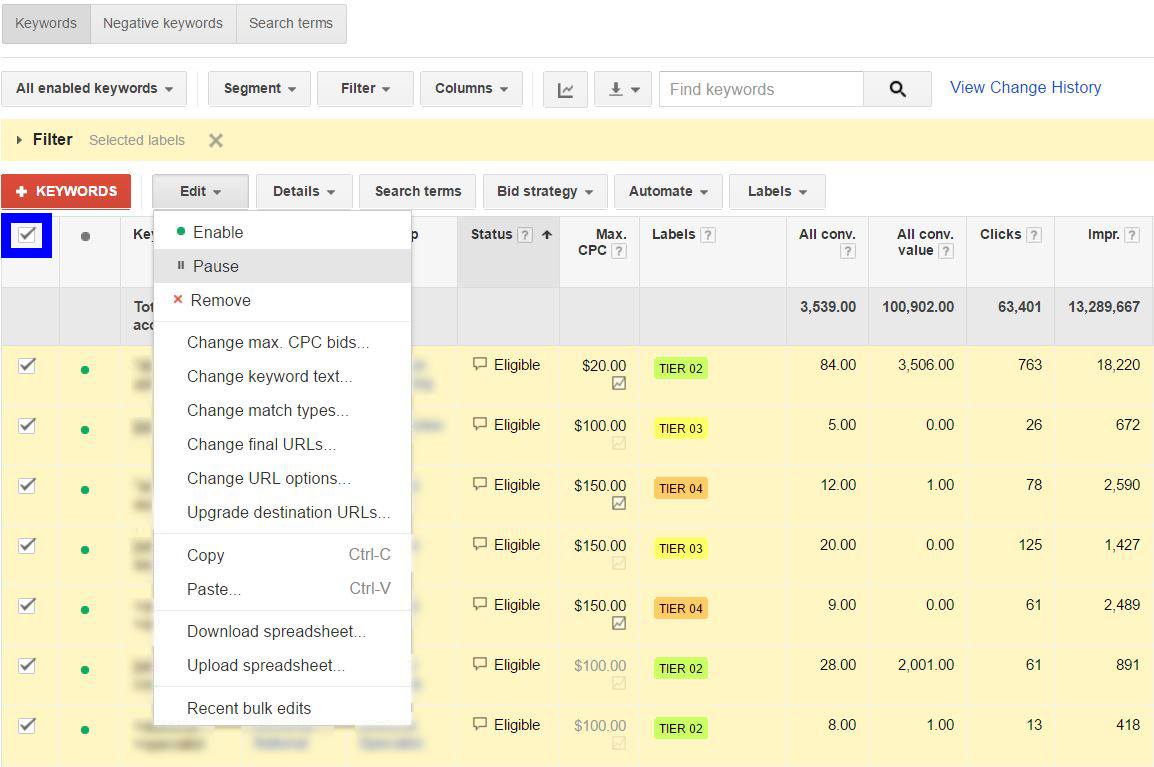
With just a few clicks, you’ve shut down your less efficient keywords and focused your ad spend on your best clicks and conversions!
This tactic is both incredibly simple and incredibly powerful. For example, we implemented keyword tiering for a client last year and saw their cost-per-conversion drop by 62% over the next 3 months.

More importantly, this improvement carried through to their cost-per-sale, which meant that keyword tiering tripled the profitability of their AdWords campaigns.
Why? Because we were using their budget to drive the best possible lead volume in any given situation.
Conclusion
At Disruptive, we’ve used keyword tiering to help numerous clients make the most out of their paid search budgets. However, despite the power of this tactic, I can count on one hand the number of times I’ve audited an account and seen a potential client using keyword tiering.
I’d like to see that change.
So, if you’d like some help using keyword tiering to improve the performance of your paid search account, let me know here or in the comments. I’ll walk you through the process and show you how to get the most out of your keywords.
What do you think of “keyword tiering”? Have you ever tried a similar tactic? What were your results?




